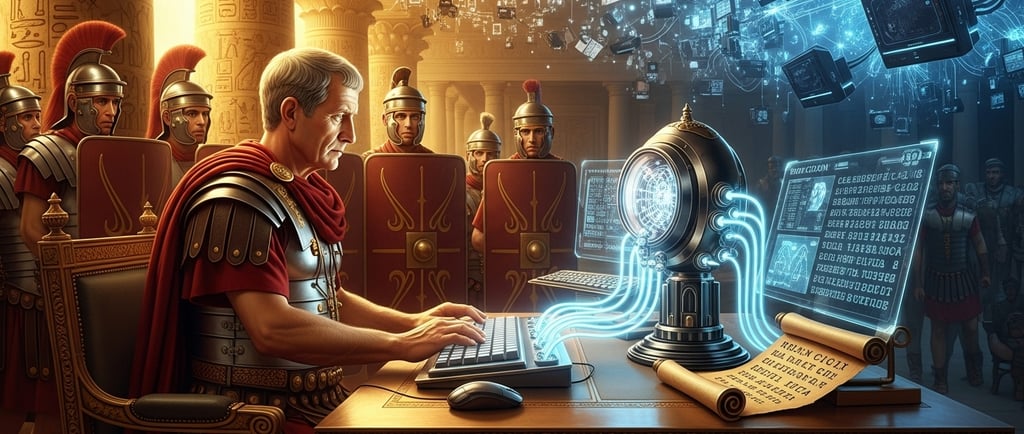Cryptography Down the Ages: From Ancient Secrets to Quantum Security
Embark on a captivating journey through the evolution of cryptography, from ancient Spartan Scytales and Caesar’s ciphers to modern AES and quantum-resistant algorithms. This article traces the history of encryption, blending historical milestones with cutting-edge innovations, offering a fascinating glimpse into securing our digital future.
CYBERSECURITYQUANTUM COMPUTINGTECHNOLOGY
Dr. Bibhu Prasad Rath
7/22/20254 min read


In my infancy I found my parents communicating and often chuckle at each other in a language that seemed difficult to comprehend, but they would be eloquent and converse for long with our names rhyming in between, only to spur our curiosity and exasperation. As we grew up, we came across a different language our elder cousins used that was brief, combining rhymes and suppressing the onset of words, besides picking up from anecdotes to build the vocabulary. The basic purpose was to communicate effortlessly to the intended receiver an encrypted message that was difficult to be deciphered by others.
Early Civilizations and Basic Ciphers
Encryption and decryption evolved alongside civilizations, trade, warfare, politics, sports, and technology. The trade secrets for example were encrypted in Egypt and Mesopotamia 2000 years before Christ was born. The Scytale was an ancient Spartan cipher device in the 7th century BCE, consisting of a rod (the scytale) and a strip of parchment or leather. To encrypt a message, the strip was wrapped around the scytale, and the message was written along the length of the wrapped strip. When unwrapped, the message appeared jumbled and unreadable. To decipher, the recipient needed a scytale of the same diameter to re-wrap the strip and read the message. The key parameter for the scytale was the circumference of the rod, which determined how many letters would fit on one wrap. Knowing the circumference was crucial for decryption. Julius Caesar used a substitution cipher shifting letters by a fixed amount (e.g., A→D) for military communication; this substitution is known as Caesarean cipher.
Medieval Advances in Cryptanalysis
Al-Kindi, a Muslim polymath, wrote the first known book titled "Risalah fi Istikhraj al-Mu'amma" (On Deciphering Encrypted Correspondence), and introduced frequency analysis. Al-Kindi's work on cryptanalysis was groundbreaking. He observed that letters in a language appear with different frequencies, and he realized this could be used to decrypt messages encrypted using substitution ciphers. His method involved analyzing the frequency of letters in both the ciphertext and a known plaintext sample. By comparing these frequencies, he could deduce the substitutions used and thus decrypt the message. In English language for example, E is by far the most common letter followed by T, R, N, I, O, A, S; other letters like Z, J, K, Q, X are fairly rare.
All the encryption algorithms are based on two general principles: substitution, in which each element in the plaintext is mapped into another element, and transposition, in which elements in the plaintext are rearranged.
Substitution Techniques in which each element in the plaintext is mapped into another element. 1. Caesar Cipher 2. Monoalphabetic cipher 3. Playfair Cipher 4. Hill Cipher 5. Polyalphabetic Cipher 6. One Time Pad. Playfair cipher is a digraph substitution cipher—it encrypts pairs of letters (digraphs), not single letters. It uses a 5×5 matrix of letters based on a keyword. WWI: Use of field ciphers, such as Playfair Cipher is on record.
Vigenère Cipher (1553) Called "le chiffre indéchiffrable" (the indecipherable cipher), it used a polyalphabetic substitution with a keyword. Much harder to crack than monoalphabetic ciphers. European courts (especially the Papal court and kings of France and Spain) used cryptography extensively in diplomatic correspondence. Cipher clerks became central to espionage and statecraft.
Modern Mechanical and Mathematical Ciphers
Thomas Jefferson’s Wheel Cipher (1795) consisted of multiple disks (often 26 or 36) strung on an axle. Each disk has the letters of the alphabet arranged around its edge, with the arrangement differing on each disk. A key, which is the order in which the disks are arranged on the axle, is established beforehand. The sender aligns the disks according to the key, then rotates the wheels until the plaintext message appears in a row on the device. They then select any other row of letters on the disk to be the ciphertext and send that. The recipient, knowing the key, arranges the disks in the same order. They then locate the ciphertext row and read off the corresponding plaintext in the chosen row.
In WW-II Enigma Machine (Germany): Used electromechanical rotors to create complex substitution patterns. Allied codebreaking (Bletchley Park, Alan Turing) broke Enigma, shortening the war. Purple Cipher: Japanese cipher machine broken by the U.S.
Claude Shannon, in his work on the mathematical theory of cryptography (1949), introduced the concepts of confusion and diffusion to describe desirable properties of a secure cipher. These concepts are crucial for resisting cryptanalysis (breaking the cipher). Confusion obscures the relationship between the key and the ciphertext, while diffusion spreads the influence of a single plaintext bit across multiple ciphertext bits.
Digital Era and Symmetric Encryption
First widespread computer encryption standard. Used 56-bit keys—considered secure for a time. DES (Data Encryption Standard, 1977) Diffie-Hellman and later RSA (Rivest-Shamir-Adleman, 1977) revolutionized cryptography: Separated encryption and decryption keys. Enabled secure online communication without pre-shared secrets.
AES (Advanced Encryption Standard, 2001). Replaced DES with stronger 128/192/256-bit encryption. Advanced Encryption Standard (AES) is a highly trusted encryption algorithm used to secure data by converting it into an unreadable format without the proper key. It is developed by the National Institute of Standards and Technology (NIST) in 2001. It is widely used today much stronger than DES and triple DES AES encryption uses various key lengths (128, 192, or 256 bits) to provide strong protection against unauthorized access. This data security measure is efficient and widely implemented in securing internet communication, protecting sensitive data, and encrypting files. AES, a cornerstone of modern cryptography, is recognized globally for its ability to keep information safe from cyber threats.
Blockchain and Quantum Challenges
Bitcoin (2009) and other cryptocurrencies rely on hashing, public key cryptography, and consensus algorithms. Rise of quantum computing threatens classical encryption (especially RSA & ECC). Shor's Algorithm: This algorithm can break widely used encryption methods, like RSA, potentially compromising systems relying on public-key cryptography. Grover's Algorithm: While not as powerful as Shor's, Grover's algorithm could potentially speed up the process of breaking symmetric key encryption. The National Institute of Standards and Technology (NIST) is working on developing new, quantum-resistant cryptographic algorithms to address this threat.
Still in experimental stages research into quantum-resistant algorithms (lattice-based, multivariate, etc.). Quantum Cryptography Quantum Key Distribution (QKD) etc. offer provable security based on quantum physics. AI is now used to detect patterns in encrypted data and enhance cryptographic security. Conversely, it also raises the bar for encryption complexity.
Bibhu Prasad Rath
A.G.M, NTPC


